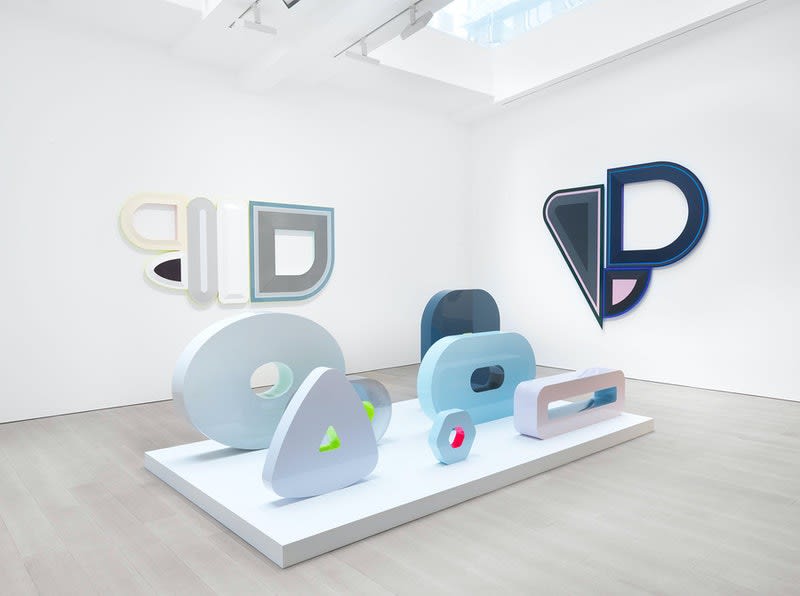For those of my generation, the first scene of Star Wars: A New Hope is embedded in collective memories. The rebel soldiers, soft, fleshy, and clad in pliable fabric, watch a plasma torch cutting through a bulkhead. Seconds later a stream of imperial stormtroopers emerge, their surfaces shiny, plastic, and impermeable, the clean lines of their armor inviting both fear and admiration. The delineation is clear: messy and flexible is good, while there is something sinister about the hard, shiny, or uniform. Beverly Fishman’s I Dream of Sleep, however, embraces this Imperial aesthetic. Untitled (High Blood Pressure, Sleepiness, Anti-Psychotic, Opioid Addiction, Two Doses) (2019), for example, is a neat grouping of five four-sided polygons in muted shades of blue and beige. Four are open at the center, becoming windows that emit a gentle pink glow, reflected from color somewhat surreptitiously painted on the underside of the component pieces. The overall form could be loosely anthropomorphic—a face or a suit of body armor—but most of all we notice the finish, as the surface modulates between zones of shimmering gloss and satiny matte.

Beverly Fishman, Untitled (Depression, Missing Dose), 2019. Urethane paint on wood, 42 1/2 x 44 x 2 inches. Courtesy the artist and Miles McEnery Gallery, New York, NY.
Fishman’s work is modular and geometric, yet eschews sharp corners: every edge is precisely rounded, but never soft. She accumulates complexity by adding more forms in series: these are cells or molecules. The overarching theme of I Dream of Sleep is opioid addiction, and by implication Fishman’s conglomerations of squares, hemispheres, pentagons, and triangles model the molecular structure of pharmaceutical “cures” for depression and other disorders. At the same time, these objects resemble sets of letters or lines of glyphs, and in this regard they have a strong linguistic appeal. Consequently, Fishman’s work has strong affinities with that of other artists who use colorful, large-format, basic geometries to construct linguistic or symbolic metaphors: Joanna Pousette-Dart, Peter Halley, and Greg Bogen all come to mind. But with her invocation of pharmaceutically-generated dystopian bliss, she most closely engages with Damien Hirst’s work of the mid ’90s. Hirst and Fishman feel similarly about the seductiveness of Big Pharma’s color palette and compositional strategies, but they differ in how they interpret the project of anesthetizing humanity.

Installation view: Beverly Fishman: I Dream of Sleep, 10 September – 10 October 2020, Miles McEnery Gallery, New York, NY. Courtesy the artist and Miles McEnery Gallery, New York, NY. Photo: Christopher Burke Studio.
Fishman’s works engage and attract the viewer viscerally, while hinting at a darker reading. The seamless surfaces of her units undulate into gentle topographies in bas-relief that invite one to touch or even to taste, like the smooth blemish-free surface of fondant icing. But they also suggest the institutional cleanliness of an object whose design is meant to distract you from its depressing purpose—prefab cabinetry in a hospital or Kevlar body armor. Her titles are more explicitly forbidding. In a series of mostly white, curved or circular pieces, the titles Untitled (Depression, Missing Dose); Untitled (Chronic Pain, Pain, Pain); Untitled (ADHD, Missing Dose) (all 2019) are very clear: this is a very appealing, but very poisonous apple. By contrast, Hirst’s “Spot Paintings,” pill displays, and pharmaceutical box paintings fall along the lines of Lewis Carroll’s “one side will make you grow taller, and the other side will make you grow shorter,” providing a far more equivocal interpretation of our addiction to mind-altering and mood-stabilizing drugs. One has to wonder whether there is, perhaps, too much darkness in Fishman’s approach. She sometimes seems caught up in her own trap: each work attracts us with luscious placid surfaces, encourages us to meditate on the erotic pleasure of craving touch or zone out in a calming, reflected orange glow, only to slap our wrist in reprimand with a punitive title.

Beverly Fishman, Untitled (Pain, Diabetes, Depression, Depression, Depression), 2019. Urethane paint on wood, 52 1/2 x 100 1/4 x 2 inches. Courtesy the artist and Miles McEnery Gallery, New York, NY.
Ultimately, however, the ability of Fishman’s work to draw in, encompass, and swallow the viewer proves the most redemptive feature of her self-inflicted dilemma. Most of the forms she uses have some kind of passage or gateway built in, either literally in the form of an aperture in their surface, or a color change that suggests the fundamental distinction between exterior and interior spaces. The seven sculptures in the exhibition are straightforward portals presenting a monolithic ovoid or heavily rounded and glossy polygon with a single opening. A silvered oval, Anxiety and Stress (2019) is perhaps the most arresting piece in the show. Its slightly cloudy reflectivity makes it seem almost transparent, or at least ethereal, while its luminescent green interior offers a clear sense of interiority. Similarly, Untitled (Pain, Diabetes, Depression, Depression, Depression) (2019), despite its oppressive name, offers five glowing and welcoming portals, and because the artist places two trapezoids at the center, the illusion of space receding draws the viewer in even further. These doorways lead to the questionable resolution of industrially or chemically enhanced escape. But this is an undeniably appealing escape from pain, discomfort, and confusion, so can we really criticize the choice to indulge?

